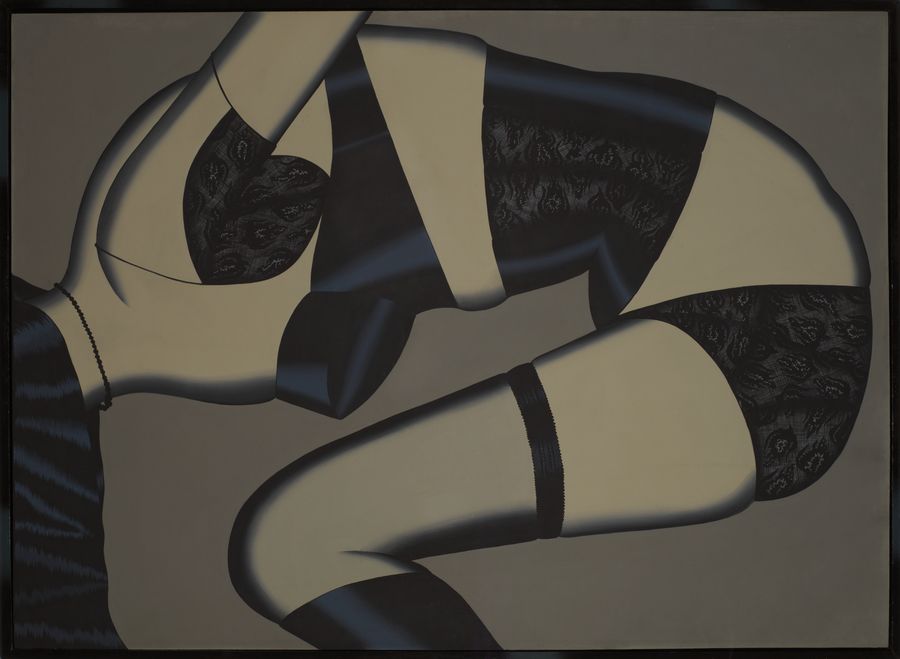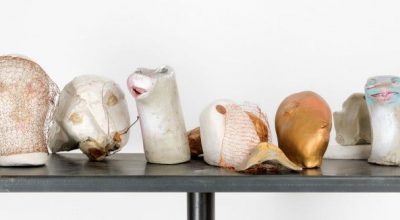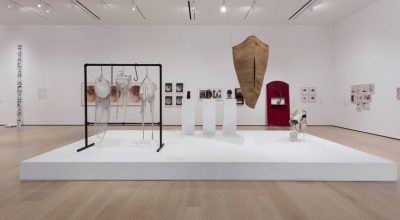
CHRISTINA RAMBERG: A RETROSPECTIVE
Hair, fur, stilettos, satin, lace, and corsets embellish and constrict female bodies in the sensuous yet sinister paintings of Christina Ramberg. Often depicted from the neck down or from behind, Ramberg’s women remain anonymous, their flesh rendered as hard and smooth as mannequins. Her work pushes boundaries by straddling figuration and abstraction, challenging idealized body types and gender representation. While she is best known for her stylized, fragmented depictions of female bodies, Ramberg also explored quilting, printmaking, and drawing.
With over 100 pieces, Christina Ramberg: A Retrospective is the first extensive survey of her oeuvre in more than 30 years. The exhibition includes key works from the Art Institute of Chicago’s permanent collection, as well as numerous loans from public and private collections, many of which have never been exhibited before.
From intimate early paintings focusing on the patterns and forms of women’s hairstyles and garments to mature works featuring cropped female torsos and hands, the exhibition at the Art Institute of Chicago showcases Ramberg’s most iconic imagery. It offers a rare opportunity to assess all phases and aspects of her evolving 20-year career.




Ramberg’s practice is a multifaceted exploration of identity and embodiment, incorporating feminist and queer theories that challenge traditional narratives. Her art critically examines how societal norms shape and constrain individual experiences, offering new insights into conventional representations and the dynamic interplay between personal and collective identities.
Moreover, her work examines how bodies are depicted and perceived, with a particular focus on issues related to disability. This aspect highlights concerns about access, visibility, and the lived experiences of individuals navigating physical and societal barriers.
Among her contemporaries, Ramberg took on roles as an archivist, note-taker, slide-maker, collector, and diarist. She amassed around 350 dolls, which she displayed on the walls of her apartment, and kept scrapbooks filled with clippings from comics, vintage advertisements, and medical illustrations. The exhibition features sketchbooks, 35mm slides, and dolls from Ramberg’s informal archive of ephemera, offering a comprehensive view of her practice and illustrating how she absorbed a wide range of source material to create her edgy yet empathetic body of work.




While Ramberg was a student at the School of the Art Institute of Chicago in the 1960s and 1970s, a sale of six-inch-square Masonite panels in the campus supply store provided a significant impetus for her work. The modestly sized Masonite squares inspired her to paint a series focused on hair textures, presented like assorted chocolates.
While at SAIC, Ramberg met Philip Hanson (whom she later married), as well as Roger Brown and Eleanor Dube, among others. Together, they formed the ‘Chicago Imagists,’ a group known for their distinctive, often surreal and whimsical style influenced by Surrealism, Art Brut, and popular culture. They exhibited their work at the Hyde Park Art Center on the South Side of Chicago between 1968 and 1969 under the name ‘False Image.’ In 1985, Ramberg became the first female Chair of the Painting and Drawing Department at the School of the Art Institute of Chicago.
Though Ramberg continued to paint on Masonite, her works began to grow in scale. In the early 1970s, her paintings showcased closely cropped images of women in luxuriously detailed lingerie. Over time, her figures became increasingly fragmented, defined only by wrappings that suggested a hair-like texture. The precision in her paintings was underpinned by extensive preparatory studies, which have since been recognized as significant works in their own right.



This evolution in her work reflects Ramberg’s intricate examination of the intersection of fashion, body image, and identity. Her painting Untitled (Bra and Stiletto) (1971-1972) exemplifies this exploration by focusing on the fetishistic aspects of fashion through its depiction of a bra and stiletto heels, embodying themes of embellishment and constraint. These themes are further developed in Untitled (Blue Corset) (1983), where the restrictive nature of a corset underscores the physical and psychological impact of fashion on the body.
In the early 1970s, Ramberg’s sleek and sensual paintings might initially appear to focus more on aesthetics than on political themes. However, her evolving female forms, which became increasingly abstract and mysterious, consistently addressed broader issues related to women’s desires, representation, and autonomy. These works convey a tension that is both captivating and unsettling, maintaining a profound relevance in today’s discussions about gender and identity.
Ramberg’s interest in cosmetic enhancement and personal identity is prominently reflected in Untitled (Lipstick and Face) (1974), which examines how beauty standards and cosmetics shape self-representation. This focus is echoed in Untitled (Tight Skirt and Fishnet Stockings) (1981), where clothing is used to uncover the intersections of sexuality and body image.
Furthermore, her critique of objectification and commodification of the female body is powerfully conveyed in Untitled (Legs and Stiletto) (1976), which challenges traditional notions of beauty through its stark and stylized representation. Collectively, these works illustrate Ramberg’s profound engagement with how fashion and material culture influence and reflect the dynamics of gender and identity.


Ramberg often omitted faces from her artwork, frequently excluding the head or covering it with hair, while highlighting the torso from behind. Reflecting on her inspiration for this style, Ramberg remarked, “I think the paintings have a lot to do with this, with watching and realizing that a lot of these undergarments totally transform a woman’s body. Watching my mother getting dressed, I used to think that this is what men want women to look like; she’s transforming herself into the kind of body men want. I thought it was fascinating… In some ways, I thought it was awful.” [i]
At the time of her first exhibitions, Ramberg’s anonymous figures were often interpreted as fetishistic studies of the female body. However, by the time of her retrospective at the Renaissance Society in 1988, critics had begun to view her work as a commentary on objectification and the artifice of modern beauty culture.


Known for her height and warmth, Ramberg often joked about her difficulty finding clothes and shoes that fit. Embracing her skills as a seamstress and quilter, she transitioned from painting to quilting in the early 1980s. This new medium allowed her to explore complex ideas beyond the constraints of paint.
Drawing inspiration from traditional patterns and historical quiltmakers, Ramberg expressed her passion for this craft in a 1989 Chicago Tribune interview: “My quilts are contemporary in the sense that I’m alive and making them now, but they’re not separate from the tradition of quiltmaking. African-American quilts are the equivalent of jazz; they ignore the rules, they break the rules, and the result is some of the most exuberant things you’ve ever seen. Making these quilts taught me that you can do what you want; you don’t have to control everything.”
It is possible that the structured geometry of quilting, combined with the electrical grid towers she observed during cross-country car trips, inspired her “satellite paintings” of the mid-1980s. These works feature grid structures set against a scumbled black background. This period marked Ramberg’s final experimentation with form before her death in 1995 at the age of 49, following a diagnosis of Pick’s disease, an early-onset form of dementia.
Ramberg’s investigation of materiality and critique of fashion’s role in commodifying the female body remain influential in contemporary art. Her work provides a framework for examining how fashion, gender, and identity intersect, shaping self-representation through societal norms and personal experiences.

[i] Kerstin Nelje, “Christina Ramberg and Luce Irigaray: A Feminist Analysis of Ramberg’s Female Figures” (master’s thesis, School of the Art Institute of Chicago, 1990), 3.
Christina Ramberg: A Retrospective is organized and curated by Thea Liberty Nichols, Associate Research Curator of Modern and Contemporary Art, and Mark Pascale, Curator of Prints and Drawings, both from the Art Institute of Chicago. The exhibition is on view at the AIC until August 11, 2024. It will then travel to the Hammer Museum in Los Angeles from October 12, 2024, to January 5, 2025, and to the Philadelphia Museum of Art from February 8 to June 1, 2025.
También te puede interesar
Marisa Merz:the Sky is a Great Space
El Hammer Museum presenta "Marisa Merz: The Sky Is a Great Space", la primera retrospectiva en Estados Unidos de la pintora, escultora e instaladora italiana Marisa Merz (1926). La muestra, que reúne cinco décadas...
ARCOmadrid 2015 EN IMÁGENES
ARCOmadrid 2015, una de las ferias internacionales más importantes, celebra su 34ª edición a partir de hoy y hasta el 1 de marzo con la participación de 218 galerías de 29 países, de las…
Andrea Giunta y Cecilia Fajardo-hill Sobre “radical Women”
Como parte de "Pacific Standard Time: LA/LA", la iniciativa del Getty que involucra unas 80 instituciones de arte en Los Ángeles y el sur de California, "Radical Women" destaca por ser la primera genealogía...



